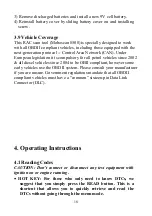
3
1.
Safety Instructions
To prevent personal injury or damage to vehicles and/or the scan tool,
read this instruction manual first and observe the following safety
precautions at a minimum whenever working on a vehicle:
Always perform automotive testing in a safe environment.
We recommend the user wears safety equipment during use.
Keep clothing, hair, hands, tools, test equipment, etc, away from all
moving or hot engine parts.
Operate the vehicle in a well-ventilated work area; Exhaust gases are
poisonous.
Put blocks on drive wheels and never leave vehicle unattended while
running tests.
Use extreme caution when working around the ignition coil,
distributor cap, ignition wires and spark plugs. These components
create hazardous voltages when the engine is running.
Put transmission in PARK (for automatic transmission) or
NEUTRAL (for manual transmission) and make sure the parking
break is engaged.
Keep a fire extinguisher suitable for fuel/chemical/ electrical fires
nearby.
Don’t connect or disconnect any test equipment with ignition on or
while engine is running. (Please refer to operating instructions for
connecting the fault code scanner cable to the car)
Keep the scan tool dry, clean and free from oil, water and grease. Use
a mild detergent on a clean cloth to clean the outside of the scan tool,
when necessary.
2. General Information
2.1 On-Board Diagnostics (OBD) II
The OBD II system is designed to monitor emission control systems
and key engine components by performing either continuous or
periodic tests of specific components and vehicle conditions. When a




































